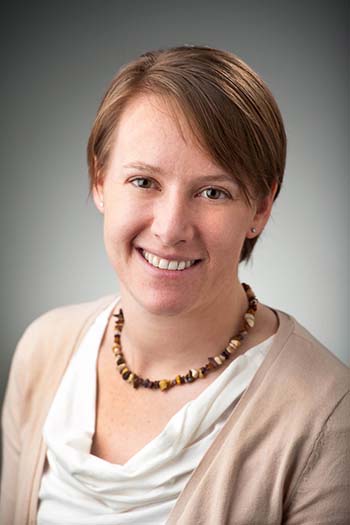
Lieve Laurens
Researcher V-Biological Science
Lieve.Laurens@nrel.gov
303-384-6196
 https://orcid.org/0000-0003-4930-3267
https://orcid.org/0000-0003-4930-3267
Research Interests
- Dynamic biochemical composition of bioenergy-relevant biomass
- Coproduct development from primary algal biomass components
- Biofuel precursor behavior during biomass conversion processes
- Algae-derived green crude valorization
- High-throughput screening technologies for compositional analysis of microbial biomass
- Standardization of algal biomass compositional analysis
- Technical standards for the algae industry
Dynamic Biochemical Composition of Bioenergy-Relevant Biomass
In order to understand the bioenergy-relevance of emerging feedstocks such as algae or other bacteria- or yeast-derived biomass, a detailed biochemical assessment of biomass composition is needed. This knowledge will ultimately aid with the optimized conversion to fuel and bioproduct intermediary feedstocks. A great example of this work is in the detailed lipid fingerprinting of oleaginous algae, where the composition of the lipids determine not just the quality and value of the biomass, but also guide the development and isolation of coproducts from these lipid streams. Lieve Laurens's research interests in this realm are primarily focused on analytical biochemistryinvestigating novel ways to understand lipid, carbohydrate, and protein production and composition in microalgae and other microorganisms. Laurens is particularly interested in the molecular dynamics of the composition of biomass in relation to outdoor environments and physiological stressors such as nutrient deprivation and light and temperature fluctuations. The influence the environment makes on the biochemical profile and the ultimate composition of the biomass can provide valuable information and guide cultivation parameters at fuel-relevant scales.
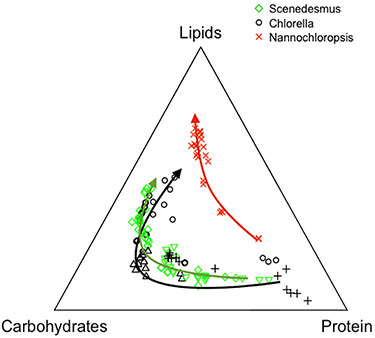
Example of selective, quantitative tradeoffs in biochemical composition of three strains of algae, grown in distinct physiological environments, each supporting the development of combined fuel and coproduct pathways from a single biomass source.
This work relates immediately to the outdoor cultivation trials that are ongoing at the Algae Testbed Public Private Partnership (ATP3), where the fundamental knowledge of the dynamic biochemistry of algae is being investigated in multiple testbed location trials of outdoor algae growth.
Coproduct Development from Primary Algal Biomass Components
The complex biochemical composition of algal biomass gives rise to the possibility of extracting and producing a range of high-value coproducts. In analogy with the notion of replacing the whole barrel of crude oil with renewable alternatives, we investigate options for the production of bio-derived chemicals that have the potential to replace petrochemical products, i.e., are of high value and command a scalable large market for their applications. We work to commensurate the conversion pathways and molecular identification of coproducts that can be derived from either algal biomass derived from three of the prevailing commercially relevant genera of algae—Scenedesmus, Chlorella, and Nannochloropsis—or one of the fractions generated during a fractionation process. We are currently establishing a relationship between each of the products, a well-described conversion and extraction process, and the respective markets that are available for commercial development. The challenges we are facing involve the effective separation of high-value coproducts in a cost-competitive manner with adequate purity for downstream conversion pathways.
Biofuel Precursor Behavior During Biomass Conversion Processes
One of the major challenges associated with algal biofuels production in a biorefinery-type setting is improving biomass utilization in its entirety, increasing the process energetic yields and providing economically viable and scalable coproduct concepts. We demonstrated the effectiveness of a novel, integrated technology based on moderate temperatures and low pH to convert the carbohydrates in wet algal biomass to soluble sugars for fermentation, while making lipids more accessible for downstream extraction and leaving a protein-enriched fraction behind. More recently, our group has focused on the impact of compositional characteristics of the biomass material on the susceptibility to pretreatment. The release of monomeric carbohydrates in the aqueous phase and extractability of the lipid fraction can be measured based on a response surface methodology, allowing for the analysis of interaction effects. We are particularly interested in the effect of harvest timing, and thereby the dynamic biochemical composition on the conversion yields and lipid quality, based on three algal strains: Chlorella vulgaris, Scenedesmus acutus, and Nannochloropsis granulata. We are combining theoretical calculations on projected fuel yields with experimental data on extractability for each of a select set of algal biomass samples tested. Simultaneously, we are investigating the impact of these novel conversion processes on the composition of lipids and how treatments affect the quality parameters of the intermediary feedstocks for the production of fuels and high-value coproducts.
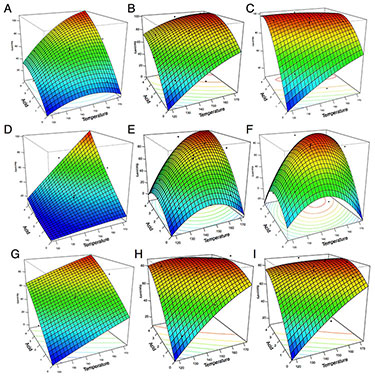
Example of the response of lipid extractability relative to the compositional characteristics of three distinct strains of algae, harvested at different intervals to influence the compositional ratio of lipid, carbohydrate, and protein content and composition.
Algae-Derived Green Crude Valorization
We are collaborating on a large multi-institutional project led by large-scale algae-producer Sapphire Energy to accelerate a path to commercial readiness of a green crude production. Green crude refers to hydrothermal liquefaction-derived crude oils from algae as feedstocks for downstream upgrading to fungible fuels, e.g., diesel blendstocks. As part of an integrated strategy to improve the yields and quality of the hydrothermal liquefaction (HTL) process, our advanced characterization work will determine the molecular composition of the HTL oils using novel, advanced analytical methodology, such as high-resolution mass spectrometry.
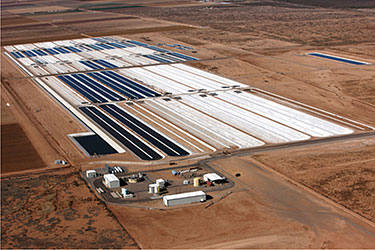
Large-scale algae farm in Columbus, New Mexico. Image courtesy of Sapphire Energy.
High-Throughput Screening Technologies for Compositional Analysis of Microbial Biomass
In order to accelerate the development of superior biocatalysts, e.g., screening populations of algae or yeasts for the highest oil-producing organisms, we are working on techniques to correlate specific fingerprints in near- and mid-infrared spectra with quantitative biochemical data using multivariate statistical models. We have demonstrated an accurate and precise quantification of algal lipid, protein, and carbohydrate composition on biomass derived from multiple individual strains of algae. The challenges in further development of this technology is developing more advanced computational algorithms that are more robust against spectral variability, which is often unavoidable when dealing with biological materials.
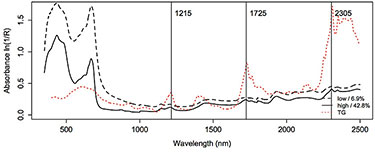
Illustration of NIR spectra of algal biomass with low and high lipid content, highlighting the spectral areas that influence the quality of the quantitative prediction of the lipid content.
Standardization of Algal Biomass Compositional Analysis
Our group works towards the coordinated development of standard analytical procedures for algal biomass characterization. To do this we are leading research on the development and validation of novel methodology to define and describe the major components of algal biomass. As part of this work, we have recently published a set of laboratory analytical procedures specifically tailored for algal biomass characterization. In addition to this work, we are part of the core team of ATP3 where the analytical characterization of production biomass and coordination of the five different teams fall under under the National Renewable Energy Laboratory's (NREL's) responsibilities.
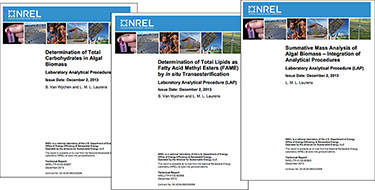
Technical Standards for the Algae Industry
The work described here is linked closely with the Algae Biomass Organization's Technical Standards Committee, where Laurens co-authored the guidance document for Industry Minimum Descriptive Language for biomass, bioproducts, and biofuels development from algae. As the chair of the Technical Standards Committee, Laurens currently leads the revisiting of the Industrial Algae Measurements (IAM) document, which is a collaborative effort and compilation of detailed recommendation on measurement methodologies for use across the industry and includes roadmaps of the regulatory environments surrounding different facets of the industry. More information can be found on the Algae Biomass Organization's website, where the IAM document can be downloaded.
Education
-
Ph.D., Biochemistry, John Innes Centre, University of East Anglia, Norwich, UK
-
D.E.S., Biotechnology, University of Paris IV, France
-
M.S., Biotechnology and Biochemistry, Ghent University, Belgium
-
B.S., Biology, Ghent University, Belgium
Professional Experience
-
Senior Scientist, NREL, National Bioenergy Center (NBC), 2011–present
-
Chair, Technical Standards Committee, Algae Biomass Organization, 2013–present
-
Staff Scientist, NREL, NBC, 2010–2011
-
Postdoctoral Researcher, NREL, NBC, 2008–2010
-
Research Associate & Project Leader, Blue Biofuels, Centre for Applied Marine Science (CAMS), Bangor University, UK, 2006–2008
Featured Publications
-
"Acid-catalyzed algal biomass pretreatment for integrated lipid and carbohydrate-based biofuels production," Green Chemistry (2014)
-
"Strain, Biochemistry and Cultivation-Dependent Measurement Variability of Algal Biomass Composition," Analytical Biochemistry (2014)
-
"High-Throughput Quantitative Biochemical Characterization of Algal Biomass by NIR Spectroscopy; Multiple Linear Regression and Multivariate Linear Regression Analysis," Journal of Agricultural and Food Chemistry (2013)
-
"Microalgae as Biodiesel & Biomass Feedstocks: Review & Analysis of the Biochemistry, Energetics, & Economics," Energy & Environmental Science (2010)
View all NREL Publications for Lieve Laurens.
Share

